Lake Titicaca is the world's highest large lake. This great body of water is also an important part of South America’s history. Some of Peru's most famous legends center around Titicaca.
There's more than just fish in these waters. An ancient city lies beneath the surface and ruins dot the shores. The islands (floating or not) are windows back in time to a simple way of life.
In this article, I will tell you how, why, and when you should make a trip to ‘The Birthplace of the Sun.
Looking for a short tour? Here are some of my favourite tours in Lake Titicaca:
- Combined Uros and Taquile Island Day Tour (leaves from Puno)
- 2-Day Budget Lake Titicaca Tour (incl. Uros, Amantani and Taquile)
- Full Day Puno Tour (incl. Lake Titicaca, Uros and Taquile)
- Floating Islands Day Tour (with lunch on Taquile)
- 2-Day Luxury Lake Titicaca Boat Tour (leaves from Cusco)
See more Lake Titicaca day tour options.
Lake Titicaca Facts
What Does Titicaca Mean?
The name ‘Titicaca’ (pronounced ti-tee-kaa-ka) cannot be traced back to one single language.
In Aymara, Titi can mean either ‘puma’ or ‘lead’. In the same language, caca- means ‘white hairs on the head’. The best translation of Titicaca is ‘a grey or rock-coloured Puma’.
Others believe that the name comes from a sacred rock located on Isla del Sol (The Sun Island) called Thaksi Cala. It’s possible that with years of mispronunciation, Thaksi Cala could have developed into Titicaca.
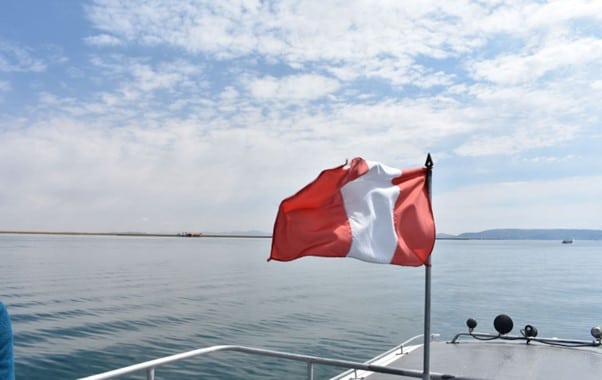
Is Lake Titicaca The Highest Lake In The World?
If you take a tour of the lake, you will likely hear that Titicaca is the highest lake in the world. This is not entirely true. If you have been to Huaraz in northern Peru (which I highly recommend), then you’ve probably trekked to higher, much smaller, lakes.
Titicaca is the highest navigable lake in the world. Basically, it is the biggest high-altitude lake. The mountain lakes are not big enough to accommodate boats.
The elevation of Lake Titicaca is 3,812m (12,507ft) above sea level. It fluctuates by about 2.5m (8.2 ft), getting higher over the rainy season. By sheer area and volume of water, Titicaca is also the largest lake in Latin America.
The highest point on Lake Titicaca is Pachamama mountain (4130m / 13, 550ft). You can hike up to this point on Amantani Island.
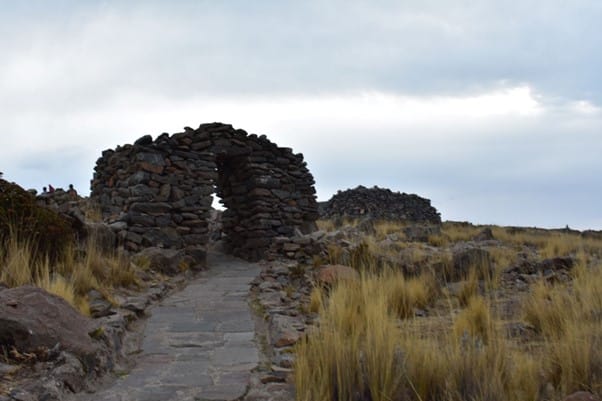
Pachamama on Amantani island
Is Lake Titicaca in Peru or Bolivia?
This is true - Lake Titicaca is in both Bolivia and Peru. The massive lake straddles the border between these countries.
There is a heated debate between Peruvians and Bolivians as to who has the bigger portion of Lake Titicaca. Regardless, you can reach beautiful islands and see epic sunsets on either side.
Please Note: You might be planning to cross the Yunguyo border between Puno (Peru) to Copacabana (Bolivia) by bus. If you take this route in either direction, the bus needs to cross the lake on a barge.
How Deep Is Lake Titicaca?
The average depth of Titicaca is between 140-180m (460-600ft). The deepest part of the lake is in the northeast corner, off Isla Soto. Here, the bed is 284m (932ft) below the surface. That’s equivalent to a 60-story building!
Is Lake Titicaca Shaped Like A Puma?
Well actually, Lake Titicaca is shaped more like a puma hunting a rabbit.
The puma is a sacred animal for the Incas, representing the power of the Earth and the land of the living. It's not surprising that this form is identified in many natural features.
Incan architects also designed settlements and structures in this shape. For example, the city of Cusco is shaped like a puma.
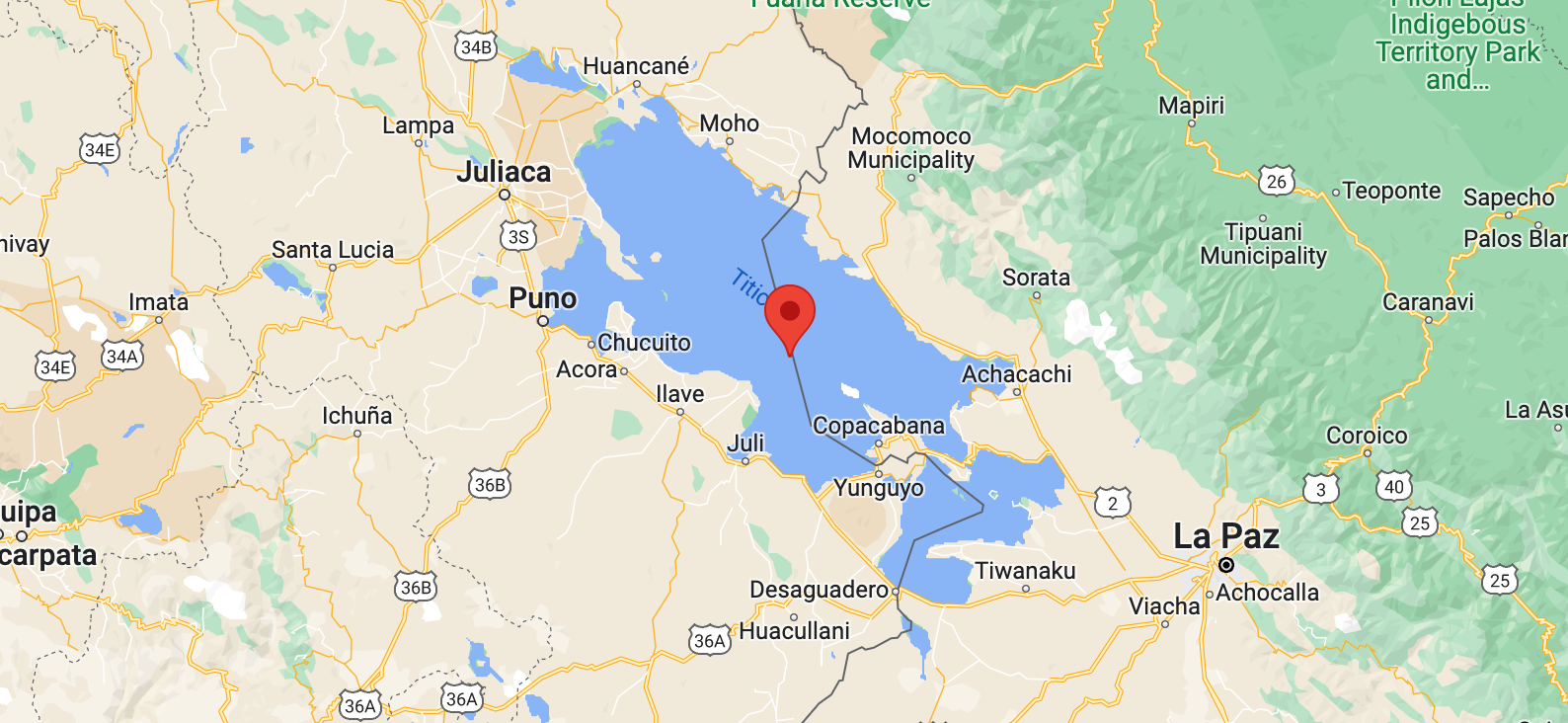
Is Lake Titicaca A Protected Area?
Titicaca was designated as a Ramsar wetland site in 1998. A large part of it is protected as a national reserve. 90% of the lake’s fish, including native Killifish and catfish, are found nowhere else in the world.
The lake, its shores, and islands are home to 530 aquatic animal species. This includes threatened species like the Flightless Titicaca grebe and the Titicaca Water frog. These massive amphibians can weigh up to 1kg (2.2. lbs.) and live in shallow areas.
Trout were introduced in 1939. These invasives make up a large part of the local diet. You’ll find fresh trout on the menu of almost every restaurant in Puno or Copacabana.
You may also like...
Where to stay? Here are 7 of my favourite accommodation options on Lake Titicaca and in Copacabana:
- Los Uros Hostel (affordable and private accommodation)
- Duque Inn (private option at budget prices)
- Qelqatani Hotel (more upmarket option)
- Totora B&B (guest-house experience at backpacker prices)
- Hostal Sonia (cheap and comfortable accommodation)
- Hotel Onkel Inn Torres (pricey but with excellent views)
- Titicaca Lodge Peru (pricey but lavish accommodation)
See more Lake Titicaca and Copacabana accommodation options.
Why Is Lake Titicaca Important?
From a historical and cultural perspective, there are several reasons why Lake Titicaca is important to this region of South America.
History of Lake Titicaca
Lake Titicaca is thought to be over a million years old. People inhabited the lake area, even before the Incan civilization. An underwater Lake Titicaca temple and ruins have been found that date back as far as 1,500 years. This is believed to have been built by the Tiwanaku people.
There is also evidence of the Colla (Qulla) and Lupaka people (other pre-Incan societies) living around the lake. They left behind extensive terracing on the islands as well as ruins on the Lake’s shore.
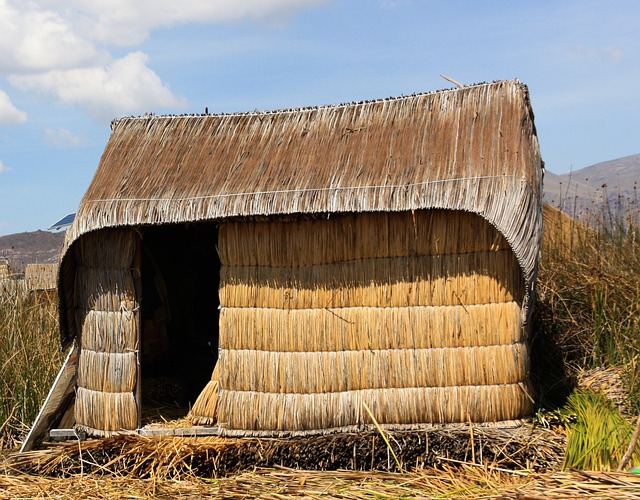
Reed houses on the Uros Islands
Lake Titicaca Legends
Lake Titicaca is extremely significant in terms of local culture. According to Peruvian mythology, Huiracocha, the god of creation, emerged from the lake and created the sun, moon, and stars.
According to Incan lore, this is where Manco Capac, the first Incan King, was born. Legend has it that he was sent down to Earth by the sun.
There have long been rumors of a lost city in the depths of Titicaca. Amazingly, this was proven true by the discovery of a submerged temple in 2000. Part of a road as well as other buildings were also discovered on the lake bottom.
Lake Titicaca and its Cultural Heritage
Islanders on Lake Titicaca have beliefs and customs that date back centuries. Their style of crafting also shows strong influences from ancient Andean civilizations.
The community of Taquile ( known as the Taquilinos) is one such example. They are recognized internationally for their fine textile works. Different designs of Chuyo hats, bags, and belts represent a person’s relationship status. These items are an important symbol of the Taquilinos culture.
Descendants of an ancient people, the Uros, still live on floating reed islands. Islanders on Aymara practice the same farming methods of growing barley, quinoa and potatoes.
Looking for a short tour? Here are some of my favourite tours in Lake Titicaca:
- Combined Uros and Taquile Island Day Tour (leaves from Puno)
- 2-Day Budget Lake Titicaca Tour (incl. Uros, Amantani and Taquile)
- Full Day Puno Tour (incl. Lake Titicaca, Uros and Taquile)
- Floating Islands Day Tour (with lunch on Taquile)
- 2-Day Luxury Lake Titicaca Boat Tour (leaves from Cusco)
See more Lake Titicaca day tour options.
Is Lake Titicaca Worth Visiting?
In short, yes. There are not many places where you have the opportunity to see a lake of this scale in South America. On top of that, the island communities are something completely unique.
To be honest, Lake Titicaca tours are very ‘foreigner curated’. Don’t let this put you off though. You can still have a great time for a low price. The Titicaca area is known for its knitting and embroidery work and it's a good place to buy authentic handmade souvenirs.
Overall, Titicaca is worth the trip from one of Peru’s major cities (see more on this below). If nothing else, you’ll have sole bragging rights after seeing the world's highest large lake.
Where Is Lake Titicaca Located?
Lake Titicaca is a huge freshwater lake located in the west of the South American continent, intersecting the borders of Peru and Bolivia. It is convenient to stop at Titicaca en route between these two countries.
There is a narrow channel that separates the lake into two parts - east and west. The Western part of the lake is in Peru’s Puno region and the Eastern Part lies in Bolivia’s La Paz region. In Peru, the smallest part is called Pequeño while it is known as Huinaymarca in Bolivia.
5 major rivers as well as nearly 20 smaller tributaries feed into Lake Titicaca. It is 190km (120 miles) long and 80km (50 miles) at its widest. The surface area of Lake Titicaca is 8,300km² (3,200 square miles).
How To Get From Cusco To Lake Titicaca?
From Cusco, it is most practical to head to Puno to access Lake Titicaca. I will provide more details on getting to Puno from Cusco below.
Fly From Cusco To Puno
The fastest way to get from Cusco to Puno is by plane, which is a one-hour flight. LATAM and SKY Airlines currently offer this route with one-way tickets costing $60 and up.
Please Note: Juliaca Airport is about 44km (27 miles) outside of Puno. You will need to take a taxi to the airport or a transfer from your accommodation near the lake.
Cusco-Puno By Bus
The cheapest way to get to Lake Titicaca is by bus from Cusco or Arequipa. Several companies offer this route during the day and as a sleeper bus. Travel time by bus from Cusco to Lake Titicaca (Puno) is between 8-9 hours.
The cost of bus tickets from Cusco to Puno start from about 40 soles / $10. I recommend shelling out a bit extra and traveling with a good bus company. In my humble opinion, Cruz Del Sur is the most comfortable and reliable operator offering this route.
Cusco-Arequipa-Puno By Bus
If you have the time and budget, I’d recommend taking a detour and spending a few days at Arequipa. This beautiful city has a calm atmosphere and gives you a good opportunity to catch your breath. If you need more adrenaline, raft down rapids or trek up a volcano (see what to do in Arequipa).
The travel time from Cusco to Arequipa is around 8 hours. I was very happy with the Oltursa bus service for this route. For 49 soles ($12), they included water and a snack.
From Arequipa, you can take another overnight bus with Cruz Del Sur to Puno (which costs about 55 soles / $14).
You Arrive In Puno Before 6 am, Now What?
If you take an overnight bus, you will arrive very early in Puno. I highly recommend heading to Ricos Pan from here. This is one of the very few cafes in Peru that is open at 6 am. The restaurant has strong WiFi connectivity, good coffee, and wholesome breakfast options. They also serve the best baked cheesecake in the country.
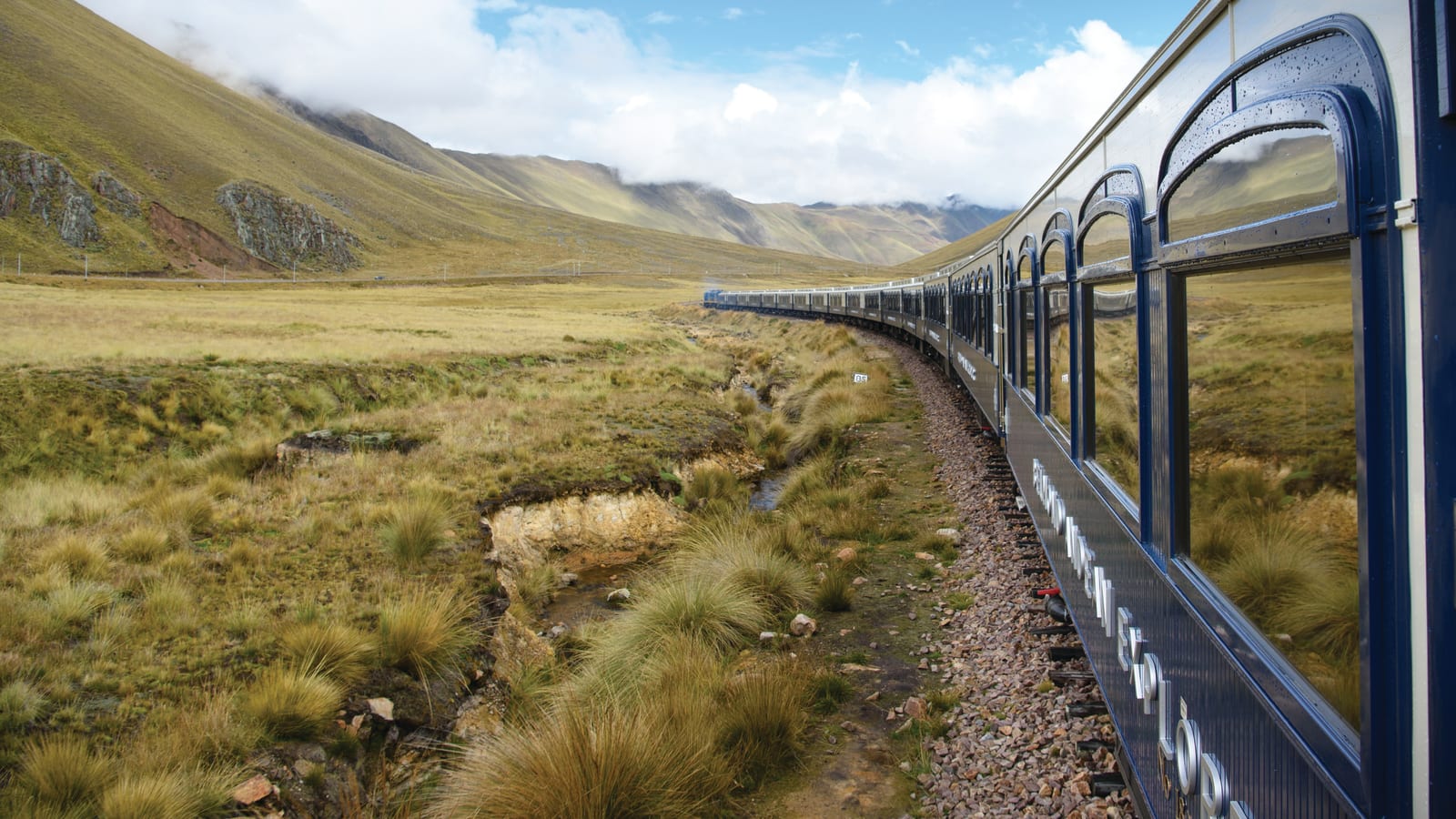
Cusco-Puno route on the Belmond Andean Explorer luxury train
Cusco to Puno By Train - Travel to Lake Titicaca in Luxury
Looking for something different? You can also get to LakeTiticaca by rail. PeruRail runs a touristic train route between Cusco and Puno, which takes 10.5 hours. This route is available every day except Tuesdays.
This is a slightly longer way to get to Titicaca, but you will be riding in style the whole way! This luxury train ride includes gourmet meals and onboard entertainment. Tickets go for around $400 for a return trip.
There is an even more luxurious train option than this. The Belmond Andean Explorer also has a Cusco-Puno-Cusco route. With private sleeper cabins and inclusive cocktails, this is a 5-star hotel on wheels. Be ready to shell out about $1,200 per person for a one way ticket.
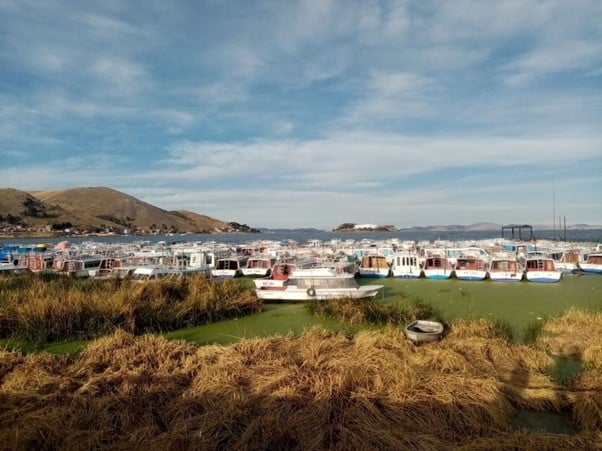
Puno harbor
Visiting Lake Titicaca In Peru
Puno is the most convenient town from which to access Lake Titicaca.
There is an Airport at Puno with daily flights to and from Lima and Arequipa.
Most people only allocate enough time to Puno to visit the lake itself. If you have some time, this small town is worth an extra day. From Puno, you can take a day trip to the floating islands of Uros. You can also visit Taquile and Amnatani from here.
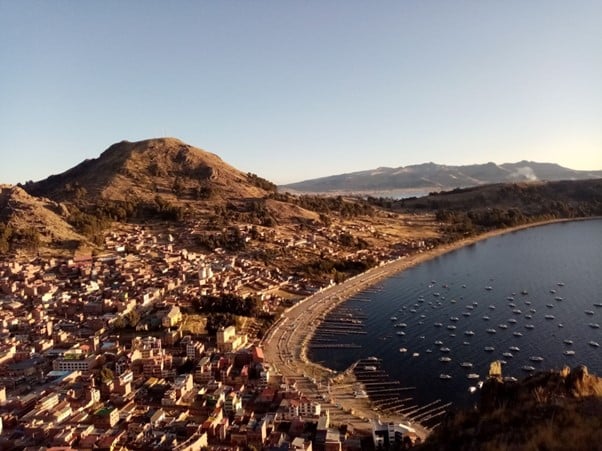
Copacabana
Visiting Lake Titicaca In Bolivia
If you are traveling from Bolivia to Puno, you may want to make a stop at Copacabana. This is a convenient town to spend a day or two in and visit the lake.
You can take a day trip or stay overnight on Isla del Sol. Boats run twice a day at 8:30 am and 1:30 pm, returning at 3:30 pm and 5 pm. Here, you can see the Chinkana Labyrinth, believed to be a training center for spiritual leaders.
What Is There To See On Lake Titicaca?
There are several things worth seeing while visiting Lake Titicaca.
Visit Titicaca’s Islands
Titicaca is most famous for its floating reed islands, known as the Islas Uros (Uros Islands). The floating islands are easily accessible from the coastal town of Puno. There are currently about 100 of these islands and they are multiplying as the islanders’ families expand.
You can visit the floating islands as a day trip or as part of a multi-island tour from Puno. If you opt for a multi-island tour, you will likely also visit Taquile. This is one of a handful of permanent islands on Lake Titicaca.
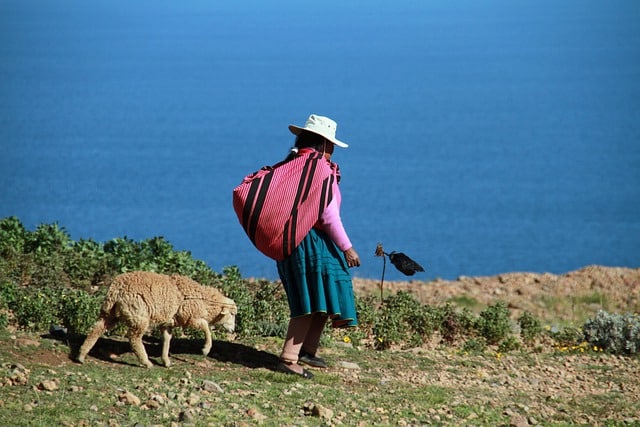
Floating islands of Uros
Spend time with an Island Family
If you enjoy more immersive experiences, you can spend the night on an Island in a village home. This is a great way to experience daily life and traditions within Lake Titicaca’s farming communities.
If you want to find out what it’s like to spend the night on one of Titicaca’s islands, you can read my personal account of an island homestay.
Ruins around Lake Titicaca
There are plenty of land-based ruins to see around Lake Titicaca. Whether in Puno or Copacabana, many ruin sites are easily accessible to visitors. Some of the Titicaca ruins even pre-date the Incan empire.
You may also like...
Wildlife
Lake Titicaca is superb for birdwatching. There are hundreds of different waterfowl who live in this aquatic habitat. Look out for Puno Ibis, flightless grebe, and Chilean pink flamingos.
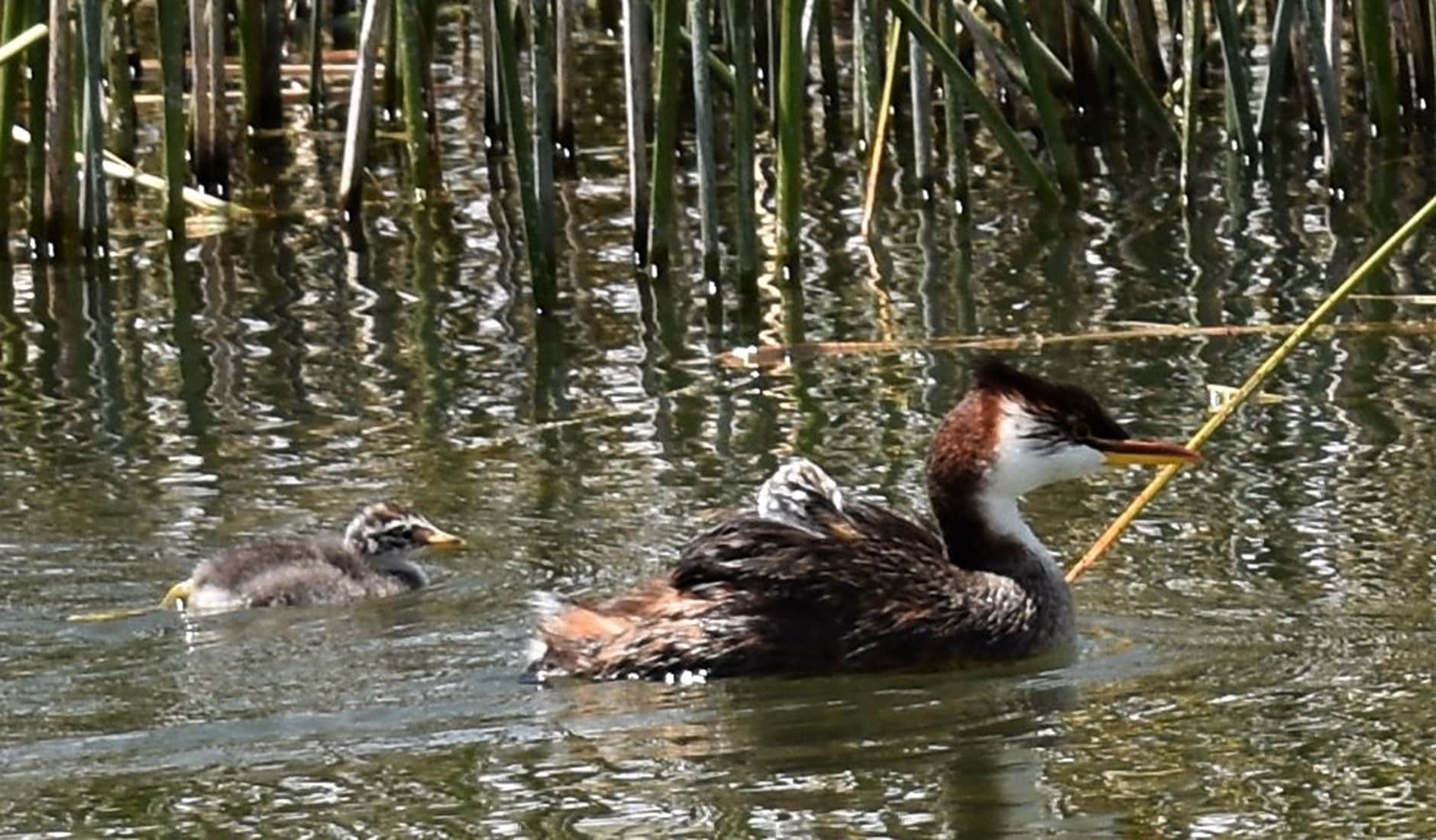
A grebe with chicks on Lake Titicaca
Can you swim in Lake Titicaca?
Technically, you can swim in Lake Titicaca. It's a huge lake and no one is going to stop you from wading in.
Before you pack your swimsuit though, know that you probably won't want to take a dip in Lake Titicaca. The water is uncomfortably cold. If you are determined to swim, brace yourself for temperatures between 10-14°C (50- 57°F).
Also, be aware that there is quite a bit of water pollution from the nearby towns.
The water in Lake Titicaca is slightly brackish too, its salinity ranging from 5.2-5.5 parts per 1000.
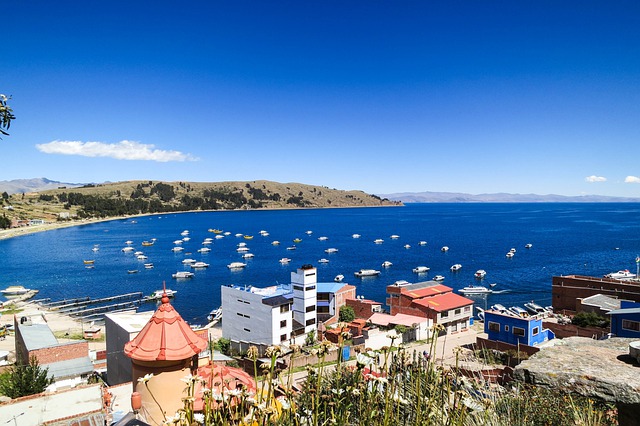
Copacabana section of Lake Titicaca
Best Time To Visit Lake Titicaca
Winter (May-October) is very dry, making it the best time to visit Lake Titicaca. During this time, the days are pleasant and mild. Be sure to pack warm clothing as evenings get icy cold.
If you want to catch the Festival de la Virgen de la Candelaria, visit Titicaca in the first two weeks of February. This is the biggest festival of the year and is celebrated in both Puno and Copacabana.
The shoulder season months of April and October offer a good balance. Chances are good for decent weather during these months. Plus, tours and accommodation are usually discounted.
On average, the lake receives 600mm of rain a year, most of which falls during thunderstorms in the summer (December-March). This is not the ideal time to be hiking around the islands.
Where to stay? Here are 7 of my favourite accommodation options on Lake Titicaca and in Copacabana:
- Los Uros Hostel (affordable and private accommodation)
- Duque Inn (private option at budget prices)
- Qelqatani Hotel (more upmarket option)
- Totora B&B (guest-house experience at backpacker prices)
- Hostal Sonia (cheap and comfortable accommodation)
- Hotel Onkel Inn Torres (pricey but with excellent views)
- Titicaca Lodge Peru (pricey but lavish accommodation)
See more Lake Titicaca and Copacabana accommodation options.
Where To Stay On Lake Titicaca
Where you stay around Lake Titicaca depends on your budget. There is a selection of hostels as well as fancier hotels to choose from. This applies to both the Peruvian and Bolivian sides of Lake Titicaca.
Read on for more reviews and recommendations of Lake Titicaca Hotels.
